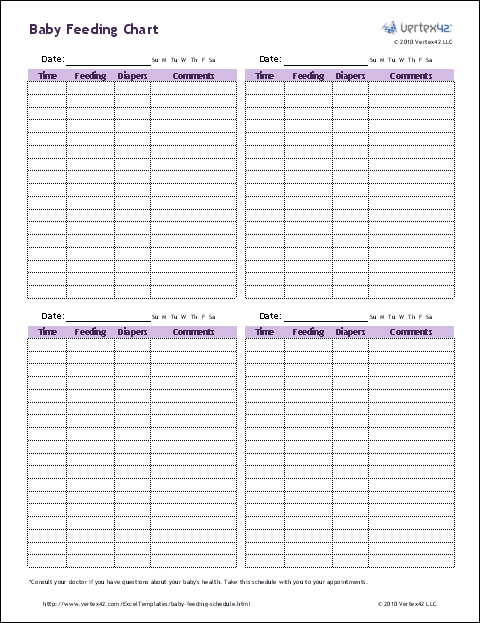As a parent, making sure that your baby is healthy and well-nourished is always a top priority. And one of the most important aspects of caring for your little one is monitoring their feeding schedule. This is why we’ve put together a free, printable baby feeding chart that you can use to keep track of your baby’s feedings.
Baby Feeding Chart
Our baby feeding chart is designed to be easy to use and contains all of the important information that you’ll need to track your baby’s feedings. You can download and print the chart, then use it to record when your baby eats, how much they eat, and what type of food they are eating.
 The chart is organized by day of the week, with spaces for recording feedings at each mealtime. This includes breakfast, mid-morning snack, lunch, mid-afternoon snack, dinner, and a late-night feeding. You can record the time that your baby eats, as well as how much they consume at each feeding.
The chart is organized by day of the week, with spaces for recording feedings at each mealtime. This includes breakfast, mid-morning snack, lunch, mid-afternoon snack, dinner, and a late-night feeding. You can record the time that your baby eats, as well as how much they consume at each feeding.
In addition to tracking feedings, our chart also has space for recording diaper changes. This includes the time of the change, whether the diaper was wet or dirty, and any notes that you might want to make about the change.
By using our baby feeding chart, you can keep a detailed record of your baby’s eating habits. This will help you identify any patterns or changes that might be worth noting, such as increased appetite or a sudden aversion to certain types of food.
How to Use Our Baby Feeding Chart
Using our baby feeding chart is easy. Simply download and print the chart, then keep it in a convenient location where you can easily access it throughout the day. When your baby eats, record the time and amount consumed on the chart. You can also record any notes about the feeding, such as how your baby seemed to enjoy the food or any reactions they might have had.
At the end of each day, you can add up the total amount of food and liquid that your baby consumed. This will give you a good overview of your baby’s eating habits and allow you to monitor their overall nutritional intake.
In addition to tracking feedings, it’s also important to pay attention to your baby’s cues and signals. For example, if you notice that your baby is fussy or crying more than usual, this could be a sign that they are hungry. Use your best judgment and trust your instincts when it comes to feeding your little one.
Tips for Feeding Your Baby
Feeding your baby can be a wonderful and rewarding experience, but it can also be a source of stress and anxiety for many parents. Here are some tips to help make feeding your baby a little easier:
- Follow your baby’s lead - Some babies are more vocal about their hunger than others. If your baby seems hungry, offer them food even if it’s not a typical mealtime.
- Experiment with different types of food - It’s important to offer your baby a variety of healthy, nutritious foods to support their development. Don’t be afraid to experiment with new foods and flavors.
- Don’t force feedings - It’s important to let your baby eat at their own pace. Don’t force feedings or pressure them to eat more than they want to.
- Stay hydrated - Both you and your baby need plenty of fluids to stay healthy. Make sure that you are drinking enough water, and offer your baby breast milk, formula, or water as needed.
- Pay attention to food allergies - If your baby experiences any unusual symptoms after eating a certain food, it could be a sign of an allergy. Talk to your pediatrician if you suspect that your baby has a food allergy.
By following these tips and using our free baby feeding chart, you can help ensure that your little one is healthy and well-nourished. Happy feeding!